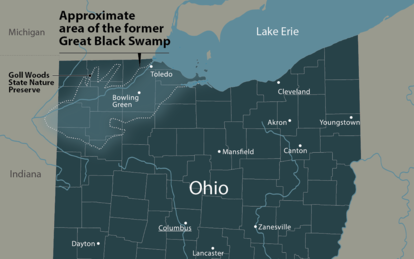The Great Black Swamp

Lake Erie was the first of the Great Lakes to emerge when North America’s Ice-Age-glaciers began pulling back about 14,000 years ago. In addition to leaving behind Lake Erie, those ice sheets also created the conditions for a nearly one-million-acre wetland complex to form along the lake’s southwest coast.
This massive network of wet forests, marshes, and wet prairies was so dense and impassable that it was dubbed the Great Black Swamp. Early colonizers struggled to move through and around it, and those who settled close to it were plagued by clouds of insects and malaria. By the middle of the 19th century there was a coordinated effort to drain it, supported by new ditching machines that could lay drainage tiles at an unprecedented pace. Within three decades, the Great Swamp was largely gone – part of a trend that would ultimately eliminate over 70% of the wetlands Ohio and Indiana had prior to European settlement.
While clearing the Great Black Swamp paved the way for new communities and created highly productive farmland, it also harvested Lake Erie’s kidneys. Lake Erie relied on this huge wetland system to filter out runoff and sediment before it could enter the lake. With this protective ecosystem gone, the new drainage ditches helped channel unfiltered farm runoff and other landside pollutants directly into Lake Erie – a problem compounded by increased industrial pollution and in-lake dumping of untreated wastewater and sewage.
Today coastal wetland restoration is increasingly viewed as essential to improving Lake Erie’s water quality and combating the destructive rise in harmful algal blooms. At the same time, many residents view Erie’s lost wetlands as a threat to urbanized areas that needed to be removed and should not be brought back. Projects like Howard Marsh Metropark in Toledo are helping to bridge this divide by making restored wetlands an accessible recreational and ecological resource for the community.